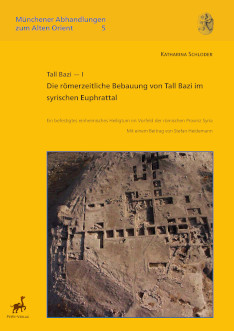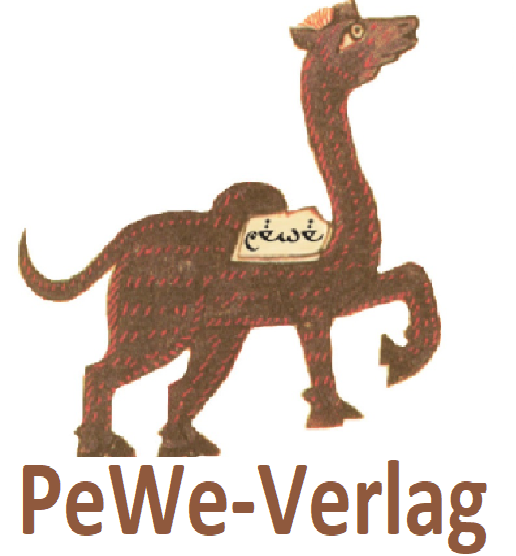
Katharina Schloder
Tall Bazi – I.
Die römerzeitliche Bebauung von Tall Bazi im syrischen Euphrattal.
Ein befestigtes einheimisches Heiligtum im Vorfeld der römischen Provinz Syria.
Münchener Abhandlungen zum Alten Orient — Band 5
Format: 30 x 21 cm — Hardcover
Umfang: 352 Seiten, mit 71, teils farbigen Abbildungen im Text sowie 100 Abbildungstafeln und 5 Faltplänen
ISBN: 978-3-935012-37-9
Preis: 65,00 €
© PeWe-Verlag 2019
Mit einem Beitrag von Stefan Heidemann
Der Fundplatz Tall Bazi, am linken Ufer des Euphrat im heutigen Syrien gelegen, ist bislang v. a. für seine bronzezeitlichen Siedlungsstrukturen bekannt. Doch fanden sich auf dem Tall auch Reste einer jüngeren Bebauung des 2. Jhs. n. Chr. Im vorliegenden Band werden zunächst die hierzu gehörenden Befunde und Funde präsentiert und analysiert. In der archäologisch-historischen Auswertung wird anschließend die Funktion Tall Bazis vor dem Hintergrund der politisch-kulturellen Situation diskutiert. Hierbei kommt der geographischen Grenzlage des Fundplatzes als Teil des Königreichs Osrhoene zwischen den beiden Großmächten Rom und Parthien eine entscheidende Rolle zu.
Bei der Anlage von Tall Bazi handelt es sich um ein befestigtes Heiligtum mit unregelmäßigem Grundriss. Der von zwei Tortürmen flankierte Hauptzugang befand sich auf der dem Euphrat zugewandten Seite. Im Inneren konnten mehrere Gebäude festgestellt werden, von denen eines als zentraler Kultbau anzusprechen ist. Aufgrund des teilweise stratifizierten Fundmaterials ist von einer Errichtung des monumentalen Heiligtums im späten 1. bzw. frühen 2. Jh. n. Chr. auszugehen. Es bestand bis in die zweite Hälfte des 2. Jhs. n. Chr.
Durch die sorgfältige und umfassende Analyse der Befunde und Funde ist es möglich, verschiedene, mit dem Heiligtum von Tall Bazi verbundene Fragestellungen zu untersuchen. So lassen sich kultische Handlungen, die im Inneren des heiligen Bezirks stattgefunden haben, durch zahlreiche Gruben in einem offenen Hofareal nachweisen. Bauweise und -form des Tempels stehen eindeutig in mesopotamischer Tradition; trotz der Lage direkt am Euphrat und somit an der Grenze zum Römischen Reich lassen sich keine hellenistisch-römischen Einflüsse in der Architektur erkennen. Dies wie auch das analysierte Fundmaterial ermöglichen Rückschlüsse auf die Identität des Erbauers und der Besucher des Heiligtums.
Mit dem Heiligtum von Tall Bazi vergleichbare Kultstätten sind im Nahen und Mittleren Osten bislang weitgehend unbekannt. Der Bearbeitung und Publikation dieses singulären Fundplatzes an der Grenze zwischen dem Imperium Romanum und dem parthischen Machtbereich kommt daher eine sehr wichtige Rolle zu.
With a contribution of Stefan Heidemann
The site Tall Bazi on the left bank of the Syrian Euphrates has so far been known mainly for its Bronze Age occupation. But the Tall yielded also remains of later architecture, namely from the 2nd century AD. This volume will first present and analyse the respective finds and findings. The ensuing archaeological and historical evaluation will consider the function of Tall Bazi against the background of the political and cultural situation. In this context, the border location of the site – a part of the kingdom of Osrhoene situated between the superpowers Rome and Parthia – is of the utmost importance.
Tall Bazi is a fortified sanctuary with an irregular ground plan. Framed by two gate towers the main access lay on the side fronting the Euphrates. Inside, several buildings could be ascertained one of which may be regarded as a central ritual building. Based on the dating of the partly stratified finds the monumental sanctuary was presumably erected in the late 1st / early 2nd century AD. It existed until the second half of the 2nd century AD.
The careful and comprehensive analysis of finds and findings allows us to address various questions connected with the sanctuary of Tall Bazi. For example, a great number of pits in an open courtyard point to ritual activities inside the sacred area. The shape and construction of the temple stand fast within the Mesopotamian tradition; despite its location right on the Euphrates river and thus at the frontier of the Roman Empire the architecture does not show any Hellenistic / Roman influence. This fact as well as the analysed material enable us to draw conclusions with regard to the identity of the builder of the sanctuary and its visitors.
Ritual places that might be comparable to the sanctuary of Tall Bazi are so far hardly known in the Middle East. It is therefore highly important that the information to be gained from this unique site on the borderline between the Roman Empire and the sphere of Parthian power is evaluated and published.
